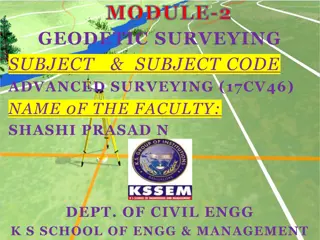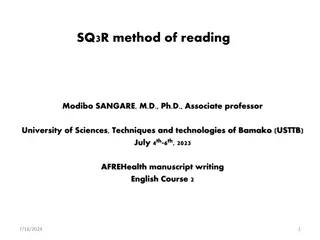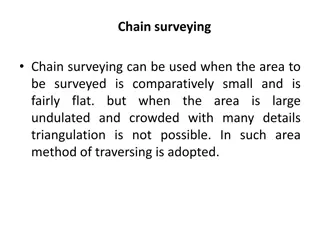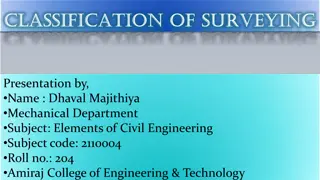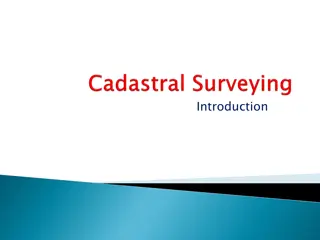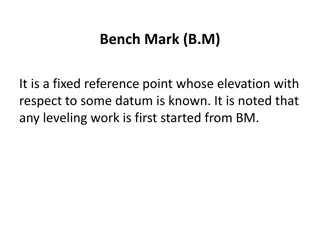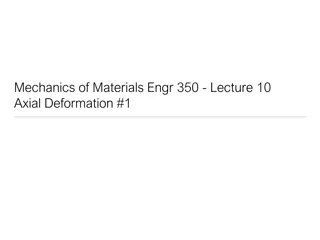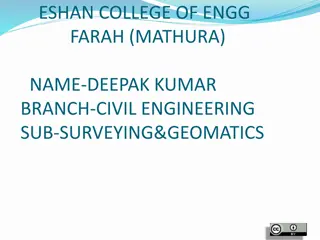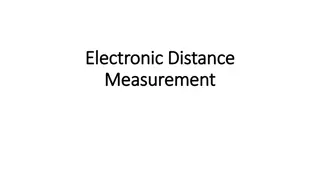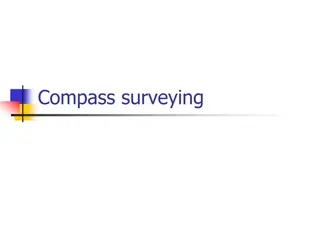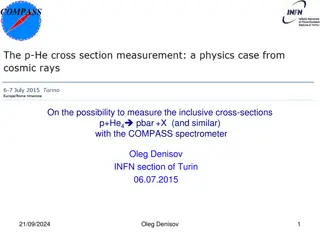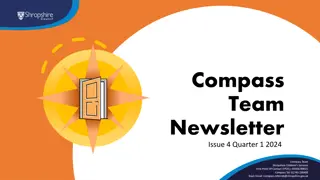Mastering Surveying with Prismatic Compass
Learn the art of determining positions on Earth's surface using a prismatic compass. Explore its parts, functions, and application in surveying, enabling precise measurements and mapping. Enhance your skills in angular and linear distance measurements with this comprehensive guide.
Download Presentation

Please find below an Image/Link to download the presentation.
The content on the website is provided AS IS for your information and personal use only. It may not be sold, licensed, or shared on other websites without obtaining consent from the author. Download presentation by click this link. If you encounter any issues during the download, it is possible that the publisher has removed the file from their server.
E N D
Presentation Transcript
PART - 1 Name : Dr .Purnima Shukla Name of the College: Durga College, Raipur (C.G.), India Name of the Faculty: Arts Designation : H.O.D. , Department of Geography Topic :SURVEYING PRISMATIC COMPASS Date : 12/07/2023
PS Prismatic Compass Surveying Surveying is the art and science of determining the relative positions of various points or stations on the surface of the earth by measuring the horizontal and vertical distances, angles and taking the details of these points and by preparing a map or plan to any suitable scale. The survey is based on the instrument known as prismatic compass. In this survey prismatic compass is used to measure the angles known as bearings and the distances are measured with the measuring tape. Thus the position of the object is determined by measuring angular and linear distances A prismatic compass is one of the most convenient and portable forms of the magnetic compass. It can be held in hand or in a tripod stand for carrying out the measurement. The line of sight is defined by the object vane and the eye vane. A prismatic compass helps to conduct both sightings and reading simultaneously. The compass is initially held over the starting station of the survey line and the adjustments are provided. The magnetic meridian is thus obtained and then starts to take the measurements by sighting to the next station. The readings increase in clockwise direction i.e. from the south (0 degrees) to West (90 degrees) and North (180 degrees) and East (270 degrees)
Parts of Prismatic Compass and Their Functions PS Cylindrical Metal Box: - Diameter of 8cm to 12cm. Protect the compass. Forms entire casing or body of the compass. Pivot: - Centre of the compass. Supports the magnetic needle over it. Lifting Pin And Lifting Lever: - Below the sight vane. Lifting pin pressed when sight vane is folded. The magnetic needle lifted out from the pivot point with the help of lifting lever Spring Brake or Brake Pin :- To damp the oscillation of the needle. To bring it to rest quickly. Magnetic Needle: - Heart of the instrument. Measures angle of a line. Always pointed to North and South pole. Graduated Circle or Ring: - Aluminium graduated circle marked with 0 and 360 to measure all possible bearings of lines. The ring is graduated to half a degree. Prism: - Read graduations on ring and to take exact reading by compass. Placed exactly opposite to object vane. The prism hole is protected by prism cap to protect it from dust and moisture.
PS Object Vane: - Diametrically opposite to the prism and eye vane. Carrying horse hair or black thin wire to sight object in line. Eye Vane: - A fine slit provided with eye hole at bottom to bisect the object from the slit. Take reading simultaneously from the eye hole. Provided with prism and can be lifted up and down by the stud to bisect the object of higher level. Sunglasses: - Used when some luminous objects are to be bisected. Placed in front of the eye slit and in bunch of 3 or 4 shades of different colors to give sharp picture of the objects only. Reflecting Mirror: - Used to get image of an object located above or below the instrument level while bisection. Placed exactly opposite to object vane. The prism hole is protected by prism cap to protect it from dust and moisture. Placed on the object vane.
PS Temporary Adjustments for Prismatic Compass The temporary adjustments usually followed for prismatic compass are: 1. Centering 2. Leveling 3. Focusing the Prism
A B
A B
A B
C B A
Methods of Prismatic Compass Survey Like Plane table survey, following methods are used for conducting the prismatic compass survey: 1. Radiation Method 2. 2. Intersection Method 3. 3. Traverse (Open and Closed) Method 4. 4. Resection Method b PS a A 1. Radiation or Radial Line Method e d c
Compass survey is carried on in two ways 1. Open Traverse Survey 2. Closed Traverse Survey A traverse is a series of connected lines whose lengths and directions are to be measured and the process of surveying to find such measurements is known as traversing. 1. Open Traverse A traverse is said to be open traverse when the traverse starts at one point and terminates at another point as shown in the figure. Open traverse is also called as unclosed traverse. It is suitable for surveying of roads, coastal lines, D PS B C A E Open Traverse
A B A B
PS 2. Closed Traverse A traverse is said to be closed traverse when the traverse formed a closed circuit as shown in the figure. In this case, both starting and terminating points of the traverse coincide with each other. It is suitable for the survey of boundaries of ponds, sports grounds, forests, etc. B C A D E Closed Traverse
C D B E A
PS Resection Method B C A D E
THANK YOU THANK YOU






